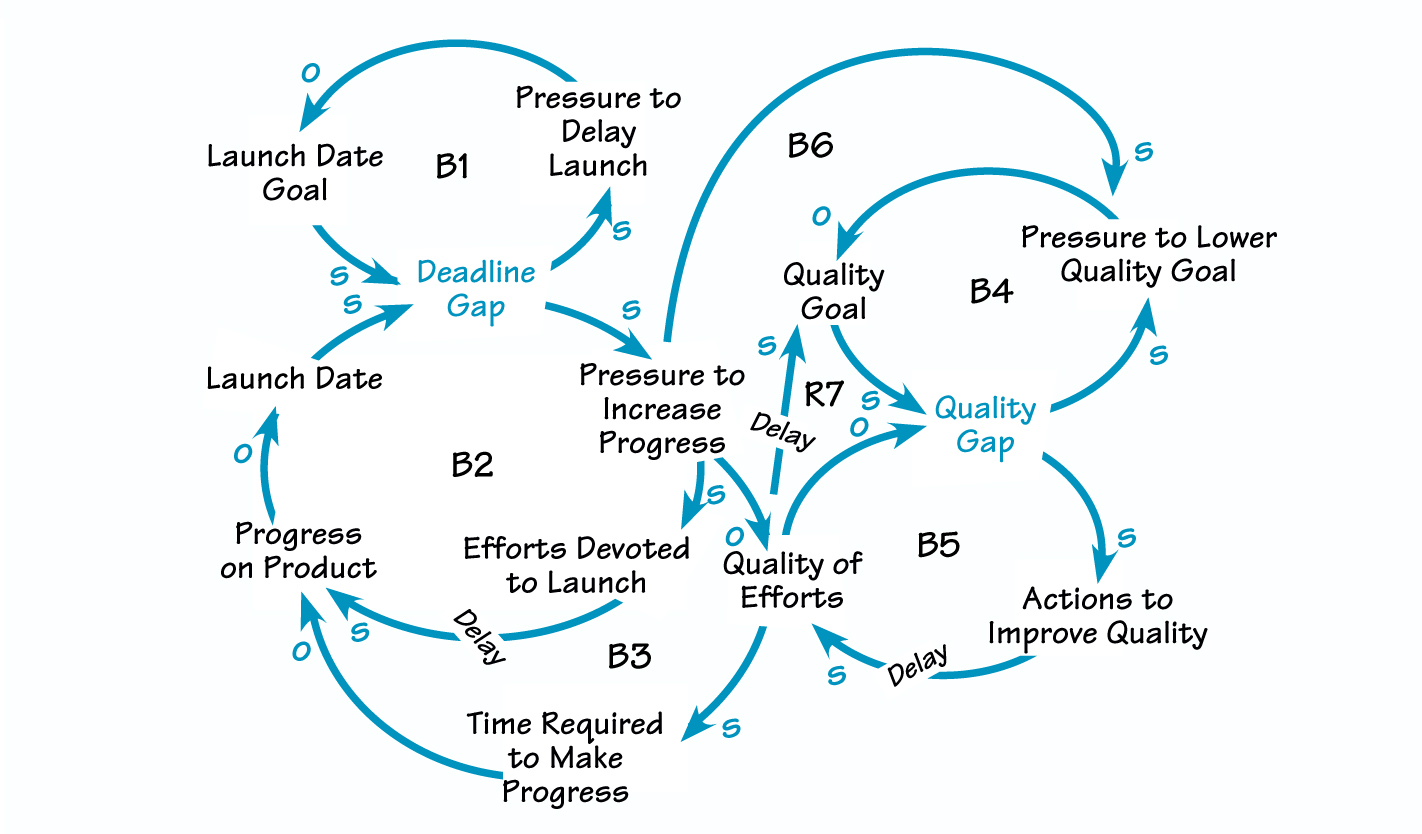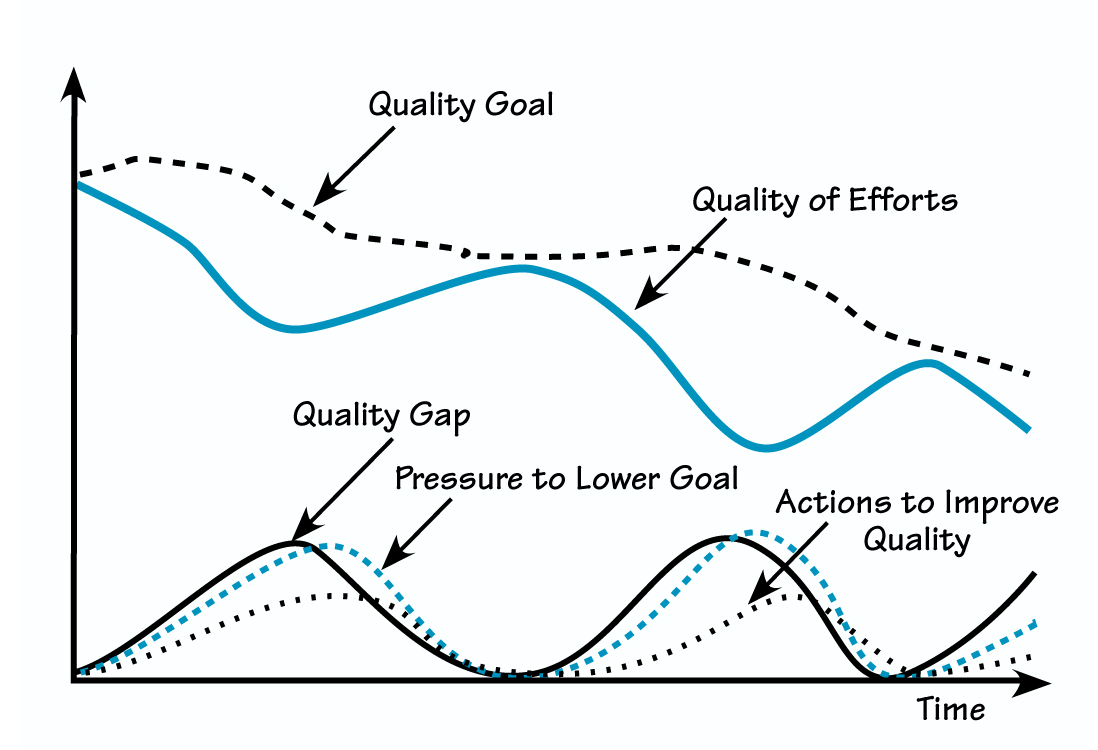It’s 7:30 a.m., and you are hurriedly getting your children ready for the day. You finally buckle everyone into the car, rush across town, and drop them off at school, only to find yourself stuck in bumper-to-bumper traffic on the way to the office. You glance at your watch. It is 8:03. You want to be early for your first meeting at your new job, but everything seems to be conspiring against you. Finally, the traffic clears as you pass the site of the accident that caused the logjam. You glance at your watch again as you pull into the parking lot at work it’s now 8:52. “So much for getting a cup of coffee before the meeting,” you mutter to yourself. You walk into the conference room, a little breathless but on time at
CLASHING GOALS

Quality and schedule sometimes conflict (B1 and B2 conflict with B4 and B5). The pressure to expedite a project increases the pressure to cut corners (B3) and lower the quality goal (B6). Over time, as the quality of our efforts declines, the quality goal declines, which reduces the gap. This leads to a further decrease in the quality of our efforts and a subsequent lowering of product quality (R7).
8:58, only to find that you are the first one there. You check your calendar to make sure that you have the right date, time, and place. Yep, you do. Around 9:05, some of your coworkers show up, and by 9:10, everyone has arrived for the “9 o’clock” meeting. So, what do you learn from this experience? Probably the same thing the others have already learned—that the, “real” starting time for meetings is never the stated time. This is a common example of the “Drifting Goals” archetypal structure.
Down the Slippery Slope
Many of us have had experiences similar to the one described above. As a group, we commit to a certain meeting time or project deadline with every intention of fulfilling that promise. Nevertheless, “life” intervenes in the form of traffic jams, more pressing deadlines, and urgent phone calls so we relax our standards around keeping the commitment. We think to ourselves, “The rest of the group is bound to be late, so I’ll spend one more minute polishing this presentation” or “Waiting an extra day for the new release won’t kill our customers!” We say 9:00 a.m., but, through our own tardiness or lack of reaction when others arrive late, we tacitly accept that it’s O. K. to begin the meeting no later than 9:05. Well, maybe 9:10, but we absolutely should start by 9:15. So, why don’t we just schedule the meeting for 9:15? Because then it’s likely to start at 9:30! This dynamic reminds us of the old adage “give him an inch, and he’ll take a mile.” It seems that once we compromise a little, we are headed down a slippery slope with no bottom in sight.
One obvious solution to drifting meeting times would be to establish accompany wide norm that meetings must begin as scheduled no matter what. Many groups have experimented with different incentives (or more accurately, disincentives) to encourage people to arrive on time ranging from monetary penalties to singing a song for being late with mixed results. For numerous organizations, though, delayed meetings are just a surface manifestation of a larger and potentially more serious pattern of drifting goals.
The Danger in Deadlines
Perhaps with things like meetings, it’s not such a big deal if everyone translates 9:00 to mean 9:15. The problem with such habits is that they have away of spreading to other areas, such as quality standards, new product launches, and marketing campaigns.
The danger lies in the tendency for all goals to drift, depending on the forces that are operating at the moment. In other words, we want a quality of 10, but when time is tight, we will settle for 9.5. If we are even more pressed,9.3 will do. And on it goes.
Some standards are more important to maintain than others. For example, new product launches generally need to stay on schedule so the company can fulfill advanced sales. But more often than not, deadlines beg into slip, often because people are juggling multiple demands. When this happens, the project manager has at least two choices about how to address the gap between the desired and actual deadline (see “Clashing Goals”). One way is to simply delay the launch date(B1), which is not an acceptable alter-native in most cases. Another way is to increase the amount of effort or resources devoted to the project so that progress can be made faster and the launch date can be met (B2). If management makes it clear that the deadline must be maintained at all costs, then this second scenario will likely occur. But if the organization doesn’t allocate the resources needed to expedite the project, people in the system must find other ways to reach the goal. One solution is to reduce the quality of efforts on the project; that is, to cut corners, which will lower the time required to produce the end-product (B3).
In some cases, taking such a shortcut makes sense in order to get acritical product out on time, even though the quality may not be up to our usual standards. The problem with this approach is that it rarely remains an isolated event, but rather becomes apart of the way we do things. The next time we get into a time bind, we may “cheat” a little on quality again because it worked the last time. So by setting rigid deadlines in isolation of other factors, we can actually create undesirable long-term outcomes, such as lower-quality products.
Competing Goals
The “Drifting Goals” phenomenon occurs more often when we are juggling competing objectives than when we are trying to meet a single target. Ideally, we would like to produce a high-quality product on schedule every time, but what happens when these two requirements seem to conflict (when B1and B2 conflict with B4 and B5)? In “Clashing Goals,” we see that the pressure to expedite a project does two things. It increases the pressure to lower the quality goal (B6)and it lessens the quality of the efforts that we can put forth. Over time, this decline in quality of efforts also has a negative effect on the quality goal itself, which creates a dangerous reinforcing dynamic. Specifically, as the quality of our efforts declines, the quality goal declines, which reduces the gap. This leads to a further decrease in the quality of our effort sand a subsequent lowering of product quality (R7).
The figure “Drifting Goals over Time” shows the long-term dynamics of this structure at work. The quality goal appears to stay stable for periods of time and drops slowly relative to the wider swings of the actual quality of efforts. This dynamic serves to mask the long-term downward trend, which is why this archetype is often referred to as the “Boiled Frog Syndrome.” The changes in the goal are slow enough that nobody detects the dangerous trend until the company is in serious, “hot water.
Identifying Interdependent Goals
DRIFTING GOALS OVER TIME

The quality goal appears to stay stable for periods of time and drops slowly relative to the wider swings of the actual quality of efforts. This dynamic serves to mask the long-term downward trend.
Returning to our original example, people in organizations constantly juggle the competing goals of getting to meetings on time and attending to a whole slew of tasks they need to accomplish. One leverage point would be to emphasize the importance of actually starting as scheduled and to ask what it would take for everyone to keep that commitment. We may discover that 9 a.m. is not the best time to accomplish this goal because there are too many other competing variables—traffic, urgent messages to return, and problems to troubleshoot. It may be that gathering at lunch time will make the goal more achievable, especially if lunch is provided! Lunch or no lunch, the principle is to establish the importance of meeting a specific goal in the context of multiple goals, and then to set up structures to minimize the conflicts between competing demands and priorities.
